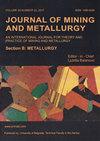氟化钙对流动氩气硅热还原法从菱镁矿和碳酸钙中提取镁的影响
IF 1
4区 材料科学
Q3 METALLURGY & METALLURGICAL ENGINEERING
Journal of Mining and Metallurgy Section B-Metallurgy
Pub Date : 2021-01-01
DOI:10.2298/jmmb210318045g
引用次数: 1
摘要
目前,镁的生产主要是在高温、高真空条件下以硅铁为还原剂进行半连续生产。为了实现镁的连续生产,提出了在流动惰性气体中用硅热法从低品位菱镁矿和碳酸钙中提取镁的新方法。研究了氟化钙(CaF2)对还原渣中氧化镁的分解速率、分解动力学、还原速率和硅酸二钙晶体类型的影响。实验结果表明,氟化钙能加速碳酸盐的分解,对煅烧产物无副作用。此外,DTA曲线分析结果表明,氟化钙可以降低预制球团中碳酸盐的分解反应活化能和反应温度。还原实验结果表明,适当的氟化钙能促进氧化镁的还原速率,在1250℃的温度范围内,~ 1350 ?,在相同的时间框架下,当还原速率达到最大值时,相应的氟化钙含量分别为5%、3%和1%。过量的氟化钙会降低氧化镁的还原速率,但会促进硅酸二钙向?相在还原渣中。本文章由计算机程序翻译,如有差异,请以英文原文为准。
The effect of calcium fluoride on extracting magnesium from magnesite and calcium carbonate by silicothermal reduction in flowing argon
At present, the production of magnesium is mainly carried out semi-continuously with ferrosilicon as reducing agent under high temperature and high vacuum. In order to continuously produce magnesium, anew method of extracting magnesium from low-grade magnesite and calcium carbonate by silicothermal method in flowing inert gas was proposed. The effects of calcium fluoride(CaF2)on decomposition rate, decomposition kinetics, reduction rate of magnesia and crystal type of dicalcium silicate in reduction slag were investigated in the paper. The experimental results showed that calcium fluoride could accelerate the decomposition of carbonate, and had no side effect on the calcined products. In addition, the analysis results of DTA curves showed that calcium fluoridecould reduce the decomposition reaction activation energy and the reaction temperature of carbonatein the prefabricated pellets. The results of reduction experiments showed that proper calcium fluoridecould promote the reduction rate of magnesia, and in the temperature range of 1250? ~ 1350?, with same timeframe, the corresponding calcium fluoride contents were5%, 3% and 1% respectively when the reduction rate reached the maximum. Excessive calcium fluoride could reduce the reduction rate of magnesia, but it couldpromote the transformation of dicalcium silicate to ? phase in the reduction slag.
求助全文
通过发布文献求助,成功后即可免费获取论文全文。
去求助
来源期刊
CiteScore
2.00
自引率
40.00%
发文量
19
审稿时长
2 months
期刊介绍:
University of Belgrade, Technical Faculty in Bor, has been publishing the journal called Journal of Mining and Metallurgy since 1965 and in 1997 it was divided in two independent journals dealing with mining and metallurgy separately. Since 2009 Journal of Mining and Metallurgy, Section B: Metallurgy has been accepted in Science Citation Index Expanded.
Journal of Mining and Metallurgy, Section B: Metallurgy presents an international medium for the publication of contributions on original research which reflect the new progresses in theory and practice of metallurgy. The Journal covers the latest research in all aspects of metallurgy including hydrometallurgy, pyrometallurgy, electrometallurgy, transport phenomena, process control, solidification, mechanical working, solid state reactions, materials processing, surface treatment and relationships among processing, structure, and properties of materials.

 求助内容:
求助内容: 应助结果提醒方式:
应助结果提醒方式:


